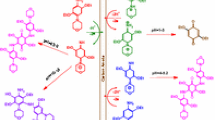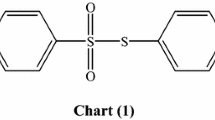Abstract
The results of kinetic and equilibrium experiments with the set of reaction of proton abstraction from 4-nitrophenyl[bis(ethylsulphonyl)]methane in acetonitrile are reported. Two strong organic bases are used: 1,5,7-triazabicyclo[4.4.0]dec-5-ene (TBD) and 7-methyl-1,5,7-triazabicyclo[4.4.0]dec-5-ene (MTBD).
The rates of proton transfer reaction have been measured by T-jump method in the presence of perchlorate of the appropriate base as a common cation BH+ and supporting electrolyte-tetrabutylammonium perchlorate (TBAP) in the temperature range between 20–40°C are: k H =1.32×107−2.00×107 and 2.82×107−4.84×107 dm 3mol−1s−1 for MTBD and TBD respectively. The enthalpies of activation ΔH ≠ MTBD =13.5 and ΔH ≠ TBD =18.1 kJmol−1. The entropies of activation are negative: ΔS ≠ MTBD =−62.3 and ΔS ≠ TBD =−40.3 Jmol−1K−1.
The change of the absorbance of the anion of 4-nitrophenyl[bis9ethylsulphonyl)]methane at the temperature 25°C in the presence of common cation BH+ gives the equilibrium constants K=705 and 906 M−1 for MTBD and TBD respectively.
Kinetic and equilibrium results are discussed. The possible mechanism of proton transfer reaction between 4-nitrophenyl[bis(ethylsulphonyl)]methane and cyclic organic bases: MTBD and TBD in acetonitrile is proposed.
Similar content being viewed by others
References
A. Jarczewski and C. Hubbard: “A review of proton transfer reactions between various carbon-acids and amine bases in aprotic solvents”,J. Mol. Struct., Vol. 649, (2003),pp. 287–307.
A. Jarczewski: “Proton transfer reaction between C-acid and organic bases in aprotic solvents”,Wiad. Chem., Vol. 54, (2000),pp. 203–226.
P. Pruszynski and A. Jarczewski: “Factors influencing kinetic isotope effects in some proton-transfer reactions in aprotic solvents”,J. Chem. Soc., Perkin Trans. II, (1986), pp. 1117–1120.
I. Grześkowiak, W. Gałęzowski and A. Jarczewski: “Kinetic study of the proton transfer reaction between 1-nitro-1-(4-nitrophynyl)alkanes and TBD and MTBD bases in acetonitrile solvent”,Can. J. Chem., Vol. 79, (2001),pp. 1128–1134.
C.F. Bernasconi: “The principle of non-perfect synchronization”,Adv. Phys. Org. Chem., Vol. 27, (1992),pp. 119–238.
F.G. Bordwell and W.J. Boyle: “Acidities, Brønsted coefficients, and transition state structures for 1-arylonitroalkanes”,J. Am. Chem. Soc., Vol. 94, (1972),pp. 3907–3911.
F.G. Bordwell, J.E. Bartmess and J.A. Hautala: “Kinetic and equilibrium acidities for nitroalkanes”,J. Org. Chem., Vol. 43, (1978),pp. 3107–3113.
T. Okuyama, Y. Ikenouchi and T. Fueno: “Stopped-flow kinetics of proton transfer involving cyclopentadiene derivatives”,J. Am. Chem. Soc., Vol. 100, (1978),pp. 6162–6166.
E.F. Caldin and S. Mateo: “Kinetic isotope effects and tunneling in the proton transfer reaction between 4-nitrophenylnitromethane and tetramethylguanidine in various aprotic solvents”,J. Chem. Soc., (1975), pp. 1876–1904.
C.D. Ritchie: “Proton transfer in dipolar aprotic solvents V. Solvation and geometric factors in the rates of proton transfer reactions”,J. Am. Chem. Soc., Vol. 91, (1969),pp. 6749–6753.
J.R. Keeffe and N.H. Munderloh: “Rates and kinetic hydrogen isotope effects for the ionization of phenylnitromethane”,J. Chem. Soc., Chem. Commun., (1974), pp. 17–18.
A.J. Kresge: “The nitroalkane anomaly”,Can. J. Chem., Vol. 52, (1974),pp. 1897–1903.
J.R. Keeffe, J. Morey, C.A. Palmer and J.C. Lee: “The nitroalkane anomaly—solvent dependence”,J. Am. Chem. Soc., Vol. 101, (1979),pp. 1295–1297.
F.G. Bordwell and W.J. Boyle, Jr.: “Brønsted coefficients and ρ values as guides to transition-state structures in deprotonation reactions”,J. Am. Chem. Soc., Vol. 93, (1971),pp. 511–514.
N. Agmon: “Is there a nitroalkane anomaly”,J. Am. Chem. Soc., Vol. 102, (1980),pp. 2164–2167.
F. Aiken, B.G. Cox, and P.E. Sørensen: “Proton transfer from carbon. A study of the acid-base-catalysed relaxation and the bromination of aryl-substituted methanedisulfones”,J. Chem. Soc., Perkin Trans. 2, (1993), pp. 783–790.
F. Hibbert: “Proton transfer from disulphonyl-activated carbon acids”,J. Chem. Soc., Perkin Trans. 2., (1973), pp. 1289–1292.
A. Jarczewski and I. Binkowska: “Proton abstraction from 4-nitrophenyl[bis-(ethylsulfonyl)]methane with TMG, TBD and MTBD bases in acetonitrile” Pol. J. Chem., Vol. 75, (2001), p. 1895–1903.
I. Binkowska, A. Jarczewski, A. Katrusiak, G. Wojciechowski and B. Brzezinski: “Structural and spectroscopic studies of the 1∶1 complex of 4-nitrophenyl[bis(ethylsulfonyl)]methane-1,5,7-triazabicyclo[4.4.0]dec-5-ene”,J. Mol. Struct., Vol. 597, (2001),pp. 101–107.
S.W. Ng, P. Naumov, S. Chantraproma, S.S.S. Raj, H.K. Fun, A.R. Ibrahim, G. Wojciechowski and B. Brzezinski: “Structural, theoretical and spectroscopic studies of the 1∶2 complex of 1,5,7-triazabicyclo[4.4.0]dec-5-ene-4-nitrophenol”,J. Mol. Struct., Vol. 562, (2001),pp. 185–196.
R. Schwesinger: “ Extremely strong, non-ionic bases: syntheses and applications”,Chimia, Vol. 39, (1985),pp. 269–275.
W. Gałęzowski, I. Grześkowiak and A. Jarczewski: “Kinetic study of the reaction of various types of C-acids with amine bases in acetonitrile. An unusual effects of common BH+ cation on the rate constants”,Can. J. Chem., Vol. 77, (1999),pp. 1042–1049.
W. Gałęzowski, I. Grześkowiak and A. Jarczewski: “Effects of steric hindrance on the rates and kinetic isotope effects of the reaction of 1-nitro-1-(4-nitrophenyl)alkanes with TBD and MTBD bases in THF”,J. Chem. Soc., Perkin Trans. 2, (1998), pp. 1607–1611.
M. Cronyn: “Methods for the preparation of certain alkanes, alkenes, acids and lactones with bis(ethylsulfonyl)methane”,J. Chem. Soc., Vol. 47, (1952), pp. 1225–1230.
G. Schroeder, B. Leska, A. Jarczewski, B. Nowak-Wydra and B. Brzezinski: “FTIR, NMR and kinetic studies of proton transfer reactions from nitro-substituted diarylmethanes to N-bases with guanidine character”,J. Mol. Struct., Vol. 344, (1995),pp. 77–88.
M. Eigen: “Proton transfer, acid-base catalysis, and enzymatic hydrolysis. Part I: Elementary processes”,Angew. Chem., Int. Ed. Engl., Vol. 3, (1964), pp. 1–19.
M. Stanczyk-Dunaj, W. Galezowski and A. Jarczewski: “Potentiometric study of equilibrium acidities of some carbon acids in acetonitrile”,Can. J. Chem., Vol. 80, (2002),pp. 1–6.
W. Gałęzowski and A. Jarczewski: “Study of the dissociation of the products of some proton transfer reactions in acetonitrile solvent”,Can. J. Chem., Vol. 70, (1992),pp. 935–942.
W. Gałęzowski, M. Stańczyk, I. Grześkowiak and A. Jarczewski: “The influence of common cation BH+ on the products of reactions between C-acids and strong guanidine bases in acetonitrile solvent”,J. Chem. Soc. Perkin Trans. 2, (1996), pp. 2647–2651.
G. Schroeder, B. Brzezinski, B. Leska, B. Gierczyk and A. Jarczewski: “Proton transfer reactions from ethyl bis(4-nitrophenyl)acetate to N-bases with guanidine-like character in acetonitrile”,Bull. Pol. Acad. Sci. Chem., Vol. 44, (1996),pp. 45–54.
E. van Aken, H. Wynberg and F. van Bolhuis: “Nitroalkanes in C−C bond forming reaction: a crystal structure of a complex of a guanidine catalyst and a nitroalkane substrate”,J. Chem. Soc., Chem. Commun., (1992), pp. 629–630.
E.F. Caldin, E. Dawson, R.M. Hyde and A. Queen: “Kinetic isotope effect in some reaction of tri-(4-nitrophenyl)-methane with alkoxide bases in various alcoholic media”,J. Chem. Soc., Faraday I, (1975), pp. 528–538.
Author information
Authors and Affiliations
About this article
Cite this article
Binkowska, I., Jarczewski, A. Kinetic and equilibrium study of the deprotonation of 4-nitrophenyl[bis(ethylsulphonyl)]methane by organic bases in acetonitrile in the presence of common cation BH+ and tetrabutylammonium perchlorate. cent.eur.j.chem. 2, 648–659 (2004). https://doi.org/10.2478/BF02482728
Received:
Accepted:
Issue Date:
DOI: https://doi.org/10.2478/BF02482728




